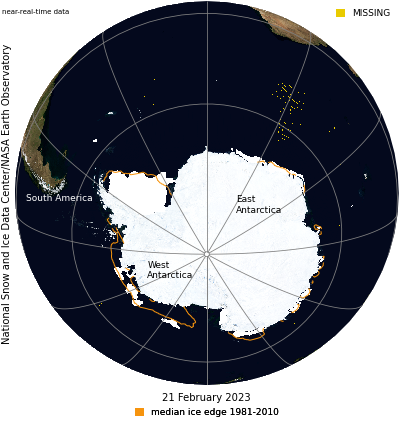
Antarctic ice is melting
We got a double whammy of news this week, about Antarctic ice. First, on February 27, 2023, the National Snow and Ice Data Center in Boulder, Colorado, said Antarctic sea ice has hit a record low, at its likely minimum extent for the year. These scientists said the sea ice surrounding Earth’s southernmost continent is now the lowest in the 45-year satellite record.
At the same time, the European Space Agency reported this week (also February 27) that scientists reviewing satellite images from the Copernicus Sentinel-1 mission – acquired between 2014 and 2021 – were “taken aback” to discover just how fast 105 glaciers on the west coast of Antarctica are flowing in the summer months.
The summer months … that’s now, in Antarctica. And the ESA scientists said:
The Antarctic Peninsula is the most northern and warmest region of Antarctica. And with a 1000-km-long [600-mile-long] mountainous spine, it is home to a rich marine ecosystem. The peninsula holds enough ice to raise global sea levels by around 7 cm [2.8 inches]. It is rapidly changing in response to the climate crisis.

Last chance to get a moon phase calendar! Only a few left. On sale now.
A record low in Antarctic ice, in 2023
Scientists at the National Snow and Ice Data Center (NSIDC) stressed that the Antarctic sea ice results are preliminary. And, they said:
… Continued melt conditions could still push the ice extent lower.
On February 21, 2023, they said, Antarctic sea ice covered 1.79 million square kilometers (691,000 million square miles). In fact, this year’s minimum extent was lower by 136,000 square kilometers (52,500 square miles) than the previous record low, set in 2022.
Ted Scambos at Cires in Boulder has traveled to Antarctica many times and published extensively on climate change in Antarctica. In addition, he also contributes to NSIDC’s Arctic Sea Ice News and Analysis page. He commented in a statement:
Antarctica’s response to climate change has been different from the Arctic’s. The downward trend in sea ice may be a signal that global warming is finally affecting the floating ice around Antarctica. But it will take several more years to be confident of it. Lower sea ice extent means that ocean waves will pound the coast of the giant ice sheet, further reducing ice shelves around Antarctica.
Julienne Stroeve, of both NSIDC and University of Manitoba, added:
The sea ice helps to buffer large floating ice shelves and major outlet glaciers such as Pine Island and Thwaites.
And if these glaciers begin a more rapid runaway loss of land ice, it could trigger a dramatic increase in sea level rise rates before the end of this century.
For more details and images, see NSIDC’s Arctic Sea Ice News & Analysis page.
A surprising ice-melt speed-up
Meanwhile, ESA was pointing this week specifically to the west coast of the Antarctic Peninsula. This is where over 100 large glaciers drain ice from the ice sheet directly into the Southern Ocean. With this in mind, a team of scientists from the University of Leeds in the United Kingdom and the Utrecht University in the Netherlands processed over 10,000 Copernicus Sentinel-1 radar images, in order to measure the speed of of these glaciers on the Peninsula’s west coast. They studied a six-year period, overall, from 2014 to 2021.
This work resulted in a paper, which the peer-reviewed journal Nature Geoscience published on February 27. In the paper, ESA said, scientists:
… describe how they found that the glaciers experiencing the most seasonal change actually flow over 22% faster in summer than winter, with all glaciers in this region speeding up by 12% on average.
Satellite data shows similar behavior to Greenland
This new discovery surprised them. That’s because, although scientists have known for a long time that glaciers in Greenland have a seasonal behavior, it’s only now that satellite data has shown similar behavior in Antarctica. In other words, faster summer ice speeds were not seen prior to this study, in this region of Antarctica. Anna Hogg from the University of Leeds commented in a statement:
The Antarctic Peninsula has seen some of the most rapid warming of any region on Earth. Continuing work like this will help glaciologists monitor how quickly change is occurring, enabling accurate assessments of how Earth’s ice will respond to climate change.

Video shows ice flow in Antarctica
The video below shows ice flow from the Trooz Glacier, on the west coast of the Antarctic Peninsula, in the year 2021.
Bottom line: Antarctic ice is melting. In late February 2023, it’s at its lowest extent in the 45-year satellite record. Also, a long-term melt study is suggesting a surprising speed-up.
Source: Widespread seasonal speed-up of west Antarctic Peninsula glaciers from 2014 to 2021











